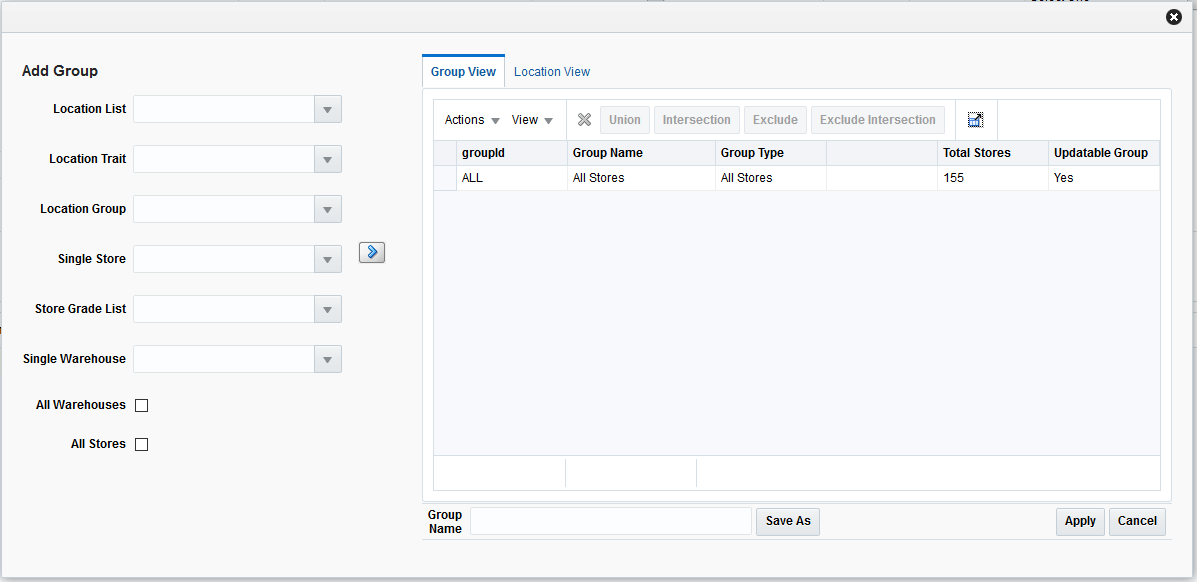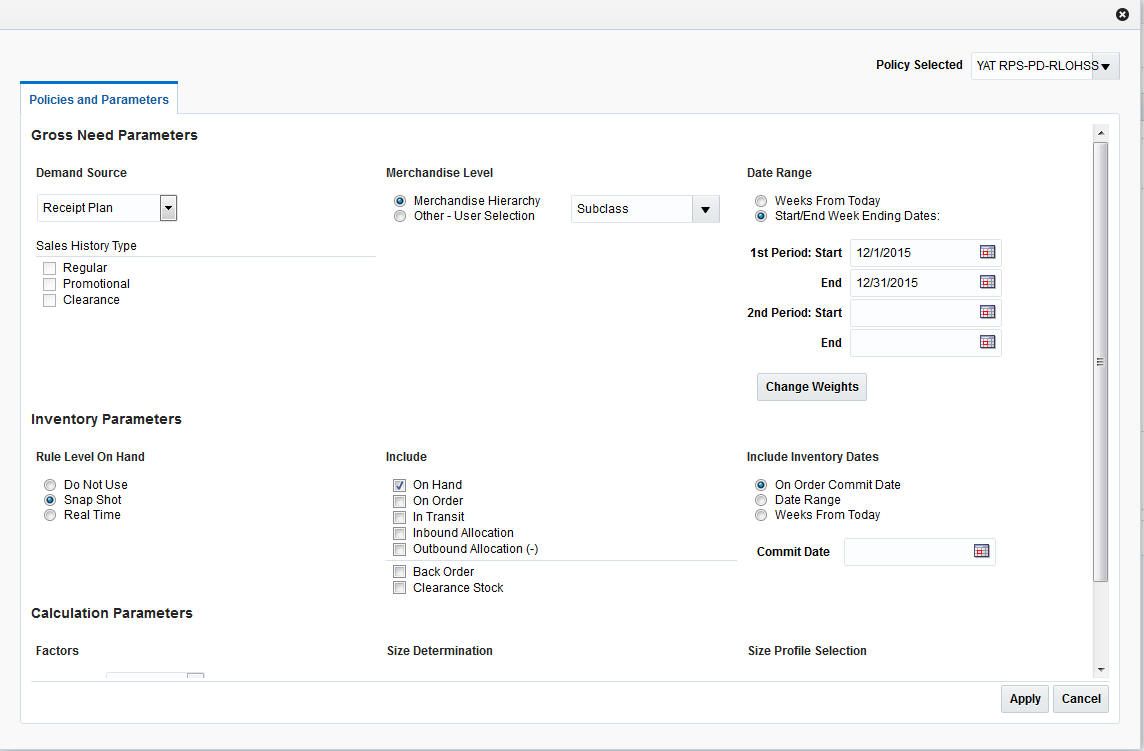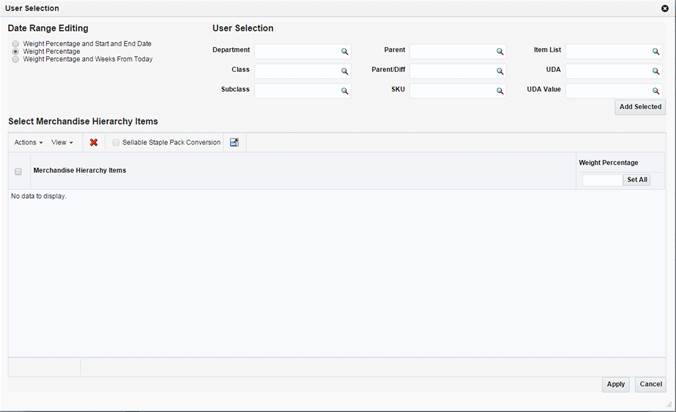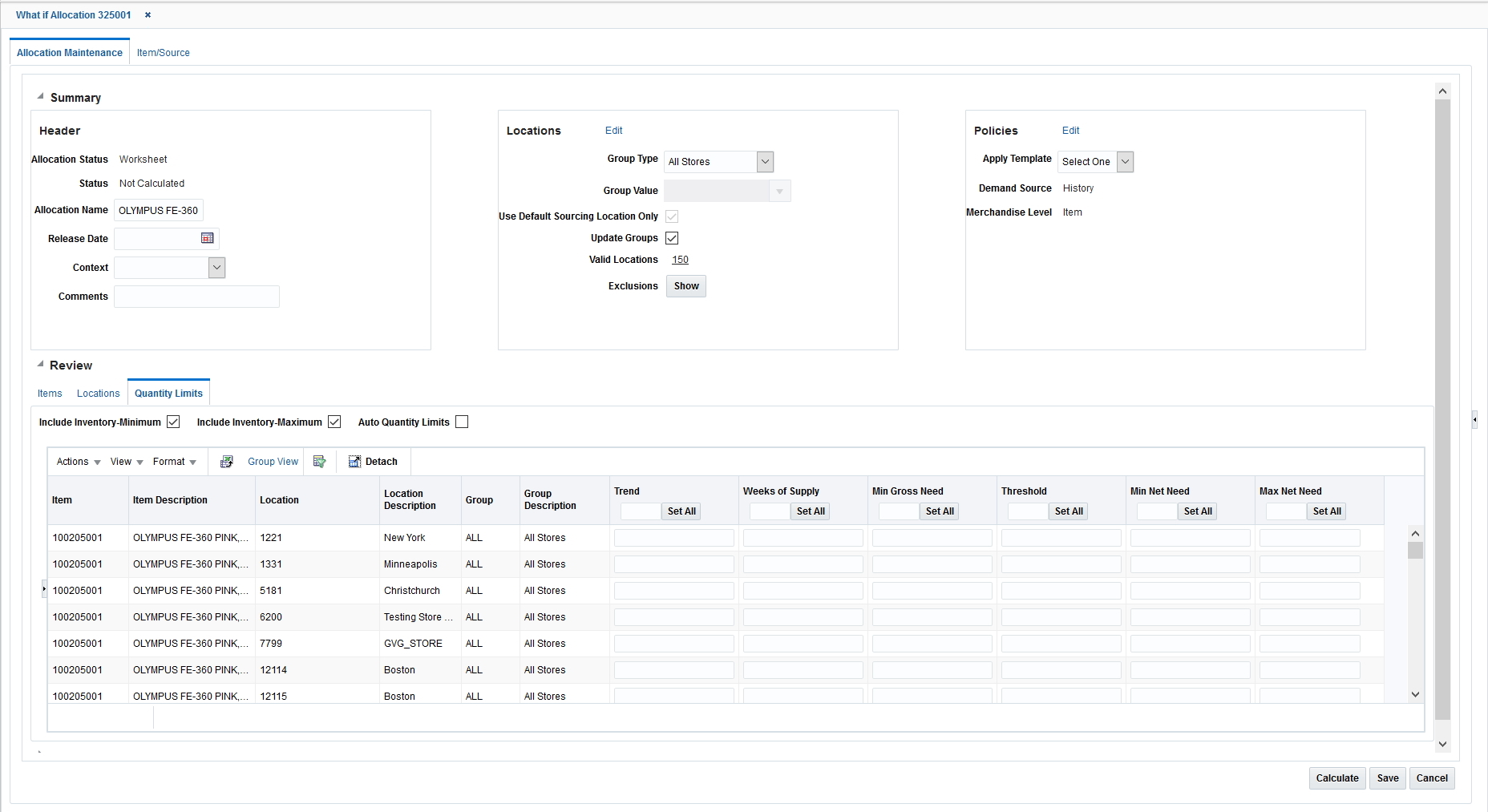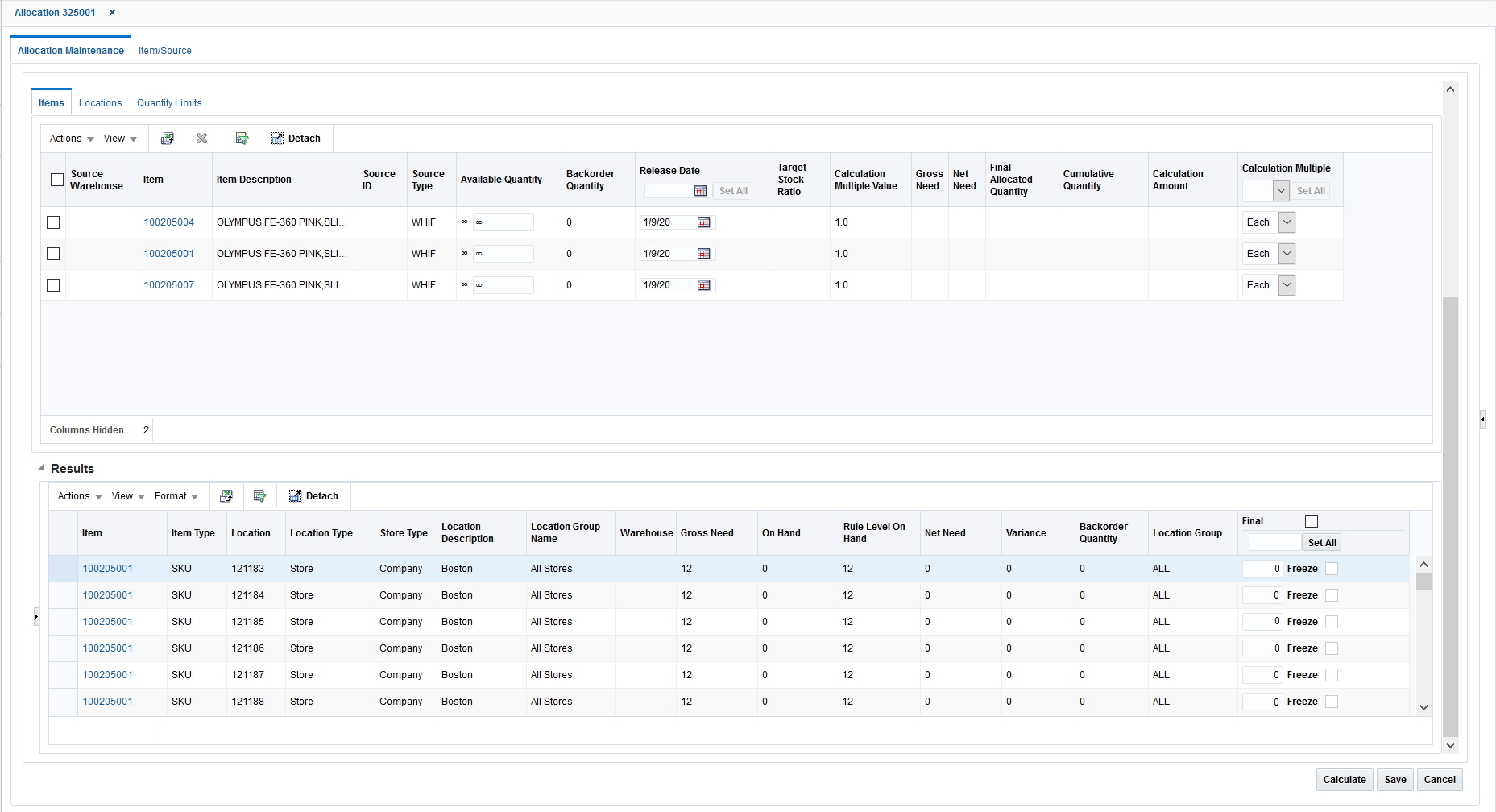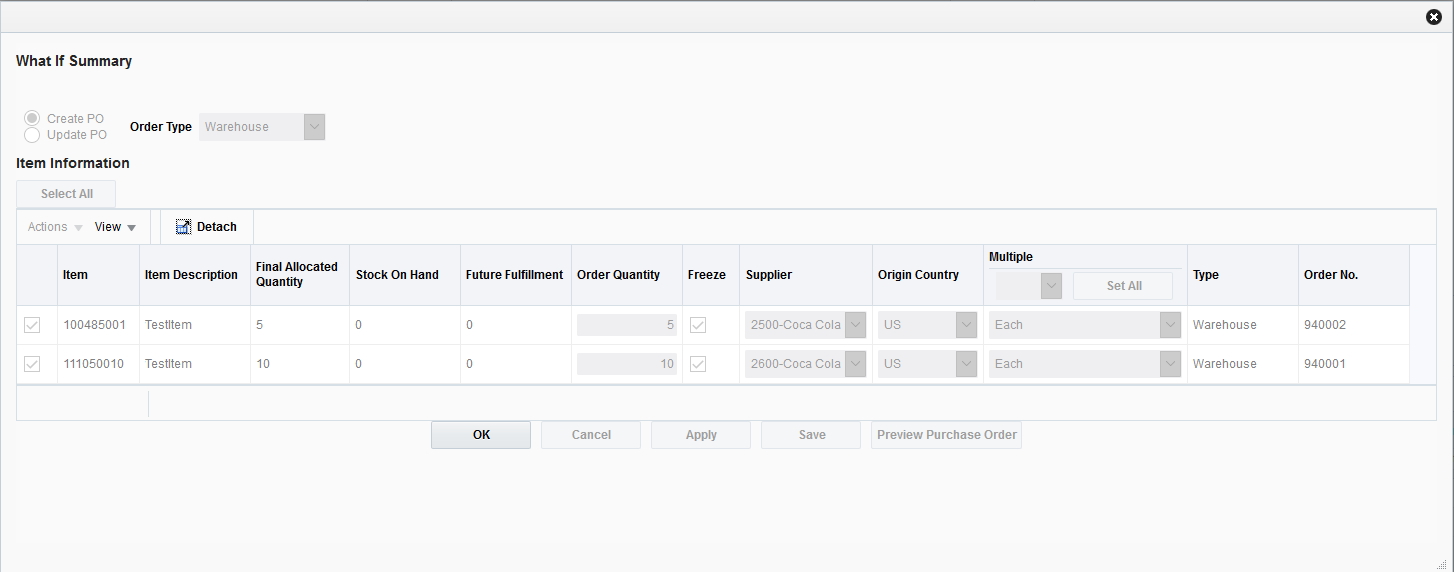3 Create an Allocation from a Worksheet
To create an allocation from the Worksheet window:
-
On the Worksheet window, select the items that you want to allocate. The Create Allocation button is enabled.
Note:
-
If you want to expand a parent to see the parent/diff's under it, select '>' to the left of the parent ID in the parent row. You can select individual items from the expanded list.
-
You can expand a pack to see its individual components by selecting '>' to the left of the pack ID. You cannot select individual components of a pack.
-
If you select a parent/diff you cannot select staple items for the same allocation.
-
You can select all items of a particular type using either one of the following options: Select All Style/Color, Select All SKU, Select All FPG, or Select All Fashion Packs.
-
-
Click Create Allocation. The Allocation Maintenance window appears. You can proceed to select locations and policies for the allocation.
Review Item Information
The Review section of the Allocation Maintenance window allows you to view items that were selected for allocation, the quantity available, the calculation multiple, and source information.
To review item information:
-
On the What-If Worksheet window, click Create Allocation. The Allocation Maintenance window appears.
-
In the Context field, select a reason why the allocation is being created (optional).
-
If you select Promotion in the Context field, select a promotion in the Promotion field.
-
In the Comments field, enter comments or notes as necessary.
Understand the Item Window
You can view the item details by clicking the Item ID link in the Worksheet or the Allocation Maintenance window. It has the following tabs:
-
Header – This provides the complete item description along with the Merchandise Hierarchy, Differentiators, and Supplier details
-
Pricing – The Current Retail and Future Retail (based on the Release Date) values are displayed here at the unit level as well as the total number of allocated units
-
UDAs – This displays any user defined attributes linked with the item in Merchandising
-
Config – Packaging details linked with the item such as the inner, case and pallet values are displayed here.
This pop up also displays an image of the item retrieved from the ITEM_IMAGE table in Merchandising.
Specify the Calculation Multiple
Select the calculation multiple from the Calculation Multiple column. Click Set All to apply the multiple to all items in the allocation. The options available are:
-
Each
-
Inner
-
Case
-
Pallet
Note:
The Inner option is not advised if you are creating a What If allocation as Inner is not a valid order rounding multiple within Merchandising. If you choose this option, you have to do the rounding manually before creating the order.To specify the calculation multiple of individual items, select the multiple from the Calculation Multiple field next to the item.
Select Locations
The Add Locations window allows you to search and select stores and warehouses for the allocation. You can add locations or groups of locations to an allocation. Various types of groups such as, Merchandising Location Lists & Traits and Allocation Groups can be used as a mechanism to select multiple locations.You can create the following complex groups:
-
A union, which includes all locations in the groups selected.
-
An intersection, which includes all locations that are duplicated in the groups selected.
-
An exclude, which excludes the locations in the groups selected.
-
An exclude intersection, which includes all locations that are not duplicated in the groups selected.
Templates are created to apply the same location combination for multiple allocations.
Add Locations
You can add locations using the Group Type field on the Allocation Maintenance window which is used for quick Add location, or if you want to select multiple groups or create a complex group then you can click the Edit Location button to access the Add Locations window.
Note:
You can select franchise locations to create an allocation for franchise stores. Allocations can be for only franchise stores or for a combination of franchise and company stores. When an allocation created for one or more franchise stores is approved, a franchise order is created.To use quick add locations:
-
On the Allocation Maintenance window, from the Locations section, select the type of group in the Group Type field. Locations brought in from the selected group are listed in the Group Value list.
-
Select the group in the Group Value field.
-
The Use Default Sourcing Location Only check box is checked and disabled in a What if allocation.
-
Select the Update Group option to specify that location groups in this allocation should be updated when the Merchandising location groups (or the Allocation Group) change.
-
Click Show next to the Exclusions field to view the item location exceptions. The Item Location Exceptions window appears listing the invalid item-location combinations.
To add locations using the Add Location window:
-
On the Allocation Maintenance window, click Edit in the Locations section. The Add Locations window appears.
-
Select the location group using the following lists:
-
Location List
-
Location Trait
-
Allocation Group
-
Store Grade List
-
Single Store
-
Single Warehouse
You can also select the All Stores and All Warehouses option.
-
-
Click the
 icon. The location groups matching the search criteria are displayed in the Group View tab.
icon. The location groups matching the search criteria are displayed in the Group View tab. -
If you want to delete any stores or warehouses before creating the location group, do the following:
-
Select the Location View tab. The stores and warehouses available in the selected location groups are displayed.
-
Select the locations you want to delete.
-
Click the delete icon.
-
-
Select the groups you want to combine to form a new location group.
-
Click the Union, Intersection, Exclude, or Exclude Intersection button to form the desired combination.
-
Optionally, enter a name in the Group Name field and click Save As to save the new location group.
-
Click Apply. The new location group is applied to the Allocation. You can review the selected locations in the Review section of the Allocation Maintenance window.
Select Policies
An allocation determines need by using a policy. You determine how the policy gathers information by selecting Level, Calculation Type, Date Range, and Sales History Type.You can customize the level a policy is applied to by using the User Selection window. Use the window to set the percentage of policies to apply to hierarchies and the time periods to constrain the policies.
To select a policy:
-
From the What If - Worksheet, select the items to allocate.
-
Click Create Allocation. The Allocation Maintenance window appears.
-
In the Policies section, you can select a predefined policy from the Apply Policy list.
-
Click Edit. The Policies window appears.
Select a Policy
-
In the Demand Source field, select the source of demand from the list of values:
Table 3-1 Select Demand Source Options
Source Description History
Use the item's historical sales for the date range selected to determine the gross need of item on the allocation.
Corporate Rules
Use custom pre-defined rules to determine the gross need of the item on the allocation.
History and Plan
Use both the item's sales history and plan for the date range selected to determine the gross need of the item on the allocation.
Forecast
Use the item's forecast for the date range selected to determine the gross need of item on the allocation.
Plan
Use the item's plan for the date range selected to determine the gross need of the item on the allocation.
Receipt Plan
Use the item's receipt plan to determine the gross need of the item in the Allocation system in order to create pre-allocations.
Plan Re-project
Use to compare the item's actual sales to the plan, re-forecast the plan based on performance for the date range selected, and use the re-projected plan to determine the gross need of the item on the allocation.
-
In the Sales History Type section, select the check boxes for the type of history to include.
Select a Level
The store demand is derived from the level of product hierarchy selected. On the Policies window, you can select to allocate items using hierarchy or user selection.
Allocate by Hierarchy
To allocate using hierarchy:
-
In the Level section, select Hierarchy.
-
Select the hierarchy level to allocate by from the list.
Note:
Item need for an allocation is determined by calculating the need for each item on the allocation from the selected rule for the organizational hierarchy level selected.
Allocate by User Selection
To allocate using user selection:
-
In the Level section, select Other - User Selection.
-
Click Edit. The User Selection window appears.
-
In the Date Range Editing section select an option:
-
Weight Percentage
-
Weight Percentage and Start and End Date
-
Weight Percentage and Weeks from Today
-
-
In the User Selection section enter an ID in the appropriate field to select a merchandise hierarchy level.
-
Click Add. The merchandise hierarchy is added to the Select Merchandise Hierarchy Items section.
-
Enter the weight or percentage to adjust the need calculated for the user selection in the Weight column.
-
Enter the start and end date in the Start Date and End Date column.
Note:
-
The Start Date and End Date fields appear only if you have selected Weight Percentage and Start and End Date option.
-
You need to select two start and end dates when the demand source is History, Forecast, or Plan.
-
-
Enter a number in the Weeks From Today column. This value specifies the number of weeks all approved allocations, direct to store orders, and transfers as stock on hand and future fulfillment, are included at the store or warehouse in the need calculation. The value can range between 1 and 52 only.
Note:
-
The Weeks From Today columns appear only if you have selected Weight Percentage and Weeks from Today option.
-
If no number is entered, the system includes all stock on hand at the store or warehouse and future inventory regardless of the date on the purchase orders or transfers.
-
Set Inventory Parameters
The inventory parameters comprise of Rule Level On Hand, Include In Inventory, and Remove Future Fulfilment.
Select Rule Level On Hand
To set Rule Level On Hand:
-
Select one of the following options available in the Rule Level On Hand section:
-
Do Not Use
-
Snap Shot
-
Real Time
Note:
-
When Rule Level On Hand is used with User Selection, the on-hands is based on the rule level of the like merchandise hierarchy selected.
-
For performance purposes, the Rule Level On Hand Snap Shot is stored in a database table which can be refreshed through a batch program to be run at your discretion.
-
Select Include in Inventory
Currently, when allocating the net need using either Stock on Hand (SOH) or Rule Level On Hand (RLOH), the values for on-hand is derived from using the summation of four Merchandising Inventory buckets. You can select to include or exclude one or more of these buckets.
To include inventory details:
Include Inventory Dates
In the Include Inventory Dates section, when you enter a date in the On Order Commit Date field, all approved allocations, direct to store orders, and transfers dated on or before the date are included in the calculation of on-hand quantity.
When you enter the number of weeks, it is used to determine how many weeks into the future should be used to pull approved allocations, direct to store orders, and transfers into the calculation for on-hand quantity.
Select a Date Range
On the Policies window, you can select the date range.
-
Enter the start date in the 1st Period Start field.
-
Enter the end date in the 1st Period End field.
Note:
You may select a second time period by entering dates in the 2nd period Start and End fields.
Enter the number of weeks to search back or forward, depending on the rule type selected. The system starts searching with the last completed week.
-
Click Change Weights. The Change Weights window appears.
Note:
The date displayed is the end of the week selected as defined in the allocation configuration files. -
Enter the new weights as appropriate.
-
Click OK to save changes.
Select Factors
-
The Type section Need Is field is defaulted to Exact and it is not editable for an allocation with infinite availability.
-
In the Mode field, select the type of algorithm calculation. The mode available is Simple.
Note:
Simple mode is applicable for both staple and fashion items. -
In the Allocate To field, select the need type for calculation, values available are Net Need and Gross Need.
Set Quantity Limits
The quantity limits section allows you to set parameters for the allocation at the item/store level. The section allows you to set the parameters for different stages of the allocation.
To set quantity limits:
-
On the Allocation Maintenance window, select the Quantity Limits tab from the Review section. The Quantity Limits window appears.
-
In the By Location Aggregate field, the location level is set to Store for Simple mode.
-
-
Select Include Inventory Minimum or Include Inventory Maximum to include stock on hand of the item at the location to calculate the net need.
Note:
The Include Inventory Minimum and Include Inventory Maximum check boxes are selected by default. -
Enter the quantity limits at the appropriate intersection for item/location and limiter.
Work with Group View
You can work at the group level using the Group view.
To use the group view:
-
On the Quantity Limits window, click the Group View link. The Group view window appears.
-
Select an option in the Set All to field. The options available are:
-
Copy: Use this option to copy the entered quantity to all the stores in the group.
-
Spread: Use this option to spread the entered quantity equally to all the stores in the group.
-
Calculate Allocation
After you allocate items, add locations, and assign policies, you can calculate the allocation. To calculate an allocation:
-
On the Allocation Maintenance window, click Calculate. The calculation of the Allocation starts. The Allocation Maintenance window is closed.
-
The calculation will process in the calculation queue. Once complete you are notified through the notifications icon. When the calculation is complete, the notification icon
 on the Allocation task bar increments in number.
on the Allocation task bar increments in number.Note:
Notifications is an optional for the application. See "Notifications" in the Oracle Retail Allocation Do the Basics User Guide for more information. -
Click the notification icon
 to display the recent notifications list.
to display the recent notifications list. -
Click the link for the allocation you want to view. The calculation results are displayed.
Generate Purchase Orders
To generate a purchase order:
-
Click What If Summary. The What If Summary window appears.
-
Select the check box next to the items you wish to place on the purchase order.
-
In the PO type field, select the type of PO you want to generate.
-
Bulk: A purchase order is generated to a redistribution warehouse and no allocation is attached to the PO. This type of PO is created during the initial planning phase when there is no information about the different warehouses which are required to receive the items. You can then have the letter of credit ready and approved before the actual order is sent.
-
Cross Dock: A purchase order is generated with a line item for each warehouse. The goods are directed from the supplier to a warehouse where it is immediately shipped out to the proper store.
Note:
In a typical Cross dock scenario, if the default warehouse for a store is also present as a destination warehouse on the What If allocation, the user will receive a pop-up while trying to raise the PO that the same warehouse cannot be specified as a source and a destination warehouse in the same allocation and hence such a cross dock Allocation cannot be created. The PO creation will be carried out. The user will then need to manually create an allocation using this PO as its source.Note:
The purchase order must be approved within the merchandising system before accessing the allocation. -
Warehouse: One purchase order is generated with multiple warehouses and quantities and no allocation is attached to the PO. The items are shipped to the warehouses which are the default sourcing locations of the destination stores in the allocation.
-
Direct to Location: A purchase order is generated created directly against the destination store or warehouse present in the What-if allocation.
Note:
Allocation produces a suggested purchase order quantity, once sent to Merchandising for approval, Merchandising item/supplier constraints are applied to determine the actual PO quantity. -
-
Click Apply.
-
Click Preview Purchase Order. The Purchase Order Preview window appears.
-
Click Create PO. The item information is sent to the merchandising system, and the PO is generated in the Worksheet status.
Note:
As the order approval takes place in Merchandising, credit check is not required here even if the allocation contains franchise stores.


